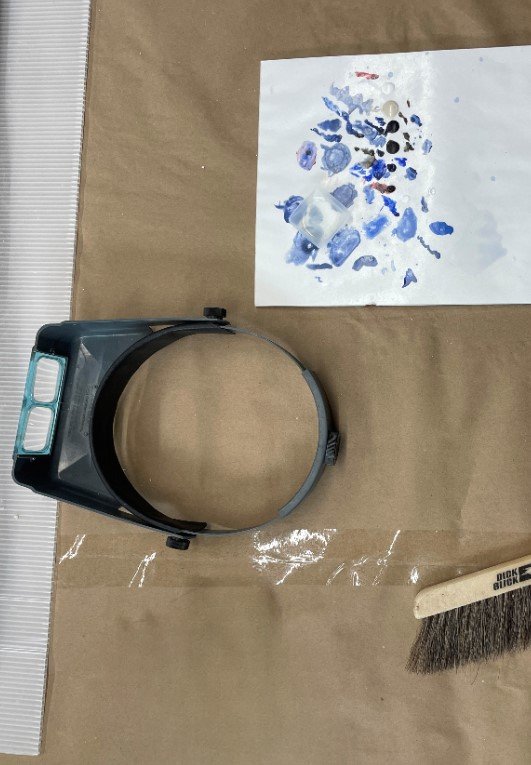Before and after treatment.
In the vibrant artistic landscape of 15th-century Florence, the della Robbia family emerged as celebrated sculptors, renowned for their bold use of color and expressive style. They employed colorful, reflective glazes on fired clay sculptures, creating a captivating interplay of light and pigment that ensured both durability and visual impact.
When a stunning, colorful relief in the manner of the della Robbia workshop arrived at The Center for treatment, we eagerly anticipated restoring this beautiful object to its former glory.
The relief prior to conservation.
Luca della Robbia, the family patriarch (1399/1400–1482), pioneered techniques that allowed ceramic sculptures to be prominently featured in outdoor public spaces. He experimented with durable glazes that made these artworks ideal for exposure to the elements, allowing them to maintain their brilliance. His use of vivid colors amplified their visual impact, captivating viewers in settings ranging from altars and chapels to public squares and private homes.
Virgin and Child in a niche, by Luca della Robbia, from the collection of the Metropolitan Museum of Art
The della Robbia workshop sourced its clay from the banks of the Arno River in Florence. The clay was meticulously cleaned and mixed with water to achieve the right pliability. Artisans shaped it by hand modeling and pressing it into plaster molds, enabling consistent reproduction of popular imagery, usually Biblical motifs. While many reliefs originated from standard molds, variations in details reveal the artisans’ skill, as they often added unique touches before the clay dried.
During this period, artisans faced limitations due to kiln sizes, but the della Robbias learned to craft their works from multiple pieces joined after firing, cleverly concealing seams along the relief's contours. Once shaped, whether as a single unit or in sections, the clay underwent two firings, transforming it into hard terracotta—a term meaning "cooked earth" in Italian.
The first firing, lasting several days, turned the clay into ceramic, with temperature control reliant on the workshop’s expertise. After this, an opaque white glaze was applied to enhance the vibrant colors against the brownish terracotta.
The relief that was brought to us for treatment was constructed from glazed terracotta, depicting The Adoration of the Christ Child. There was some plaster residue on the verso, likely from a previous installation. Minimal ceramic and glaze chip losses were noted at the edges, and the nose of Mary was fractured and separated from the figure. The proper left side of Mary’s face bore a previous restoration that covered the chin, nose, cheek, temple, and lower eye. This restoration material was applied heavily and was soluble in polar solvents. Fractures were visible in Mary’s head, running through the forehead, eye, nose, mouth, and chin. The outer portion of Mary’s palms exhibited similar restoration and visible fractures, with a slightly stepped fracture on the proper right palm. Two ceramic chip losses were present at the proper right knee of the Jesus figure, located at the lower portion of the relief. The surface was coated in plaster deposits, accretions, and grime.
A detail of an area of damage on the relief.
Josh McCauley, our senior conservator of objects and frames, promptly began his work. The object was photographed for in-house documentation before and after treatment. The verso was surface cleaned using dry methods and appropriate conservation techniques, and the remaining plaster was consolidated with a thin solution of Paraloid B-72. The recto was surface cleaned with a vacuum and brush, then treated with an appropriate surfactant and rinsed with deionized water. Remaining accretions were removed with solvent and suitable conservation methods. Previous restoration materials were extracted from the head and hands using a solvent poultice. The nose was reattached with Paraloid B-72. Large losses throughout the outer edge of the recto were filled and inpainted with acrylics, and the losses at the proper right knee of the Jesus figure were similarly addressed. Finally, any fractures and ceramic losses uncovered during the conservation of Mary were filled. Fully conserved and gleaming, this relief was ready to be returned to our client.
Look through the gallery below to watch the treatment progress. Then, scroll down to see the finished work, and read more about the fascinating provenance behind this relief!
The relief after treatment.
The techniques and production methods of the della Robbia workshop left a lasting impact that continues to be celebrated. As the workshop evolved, Luca collaborated closely with his nephew Andrea (1435–1525), who joined the enterprise in 1451 and inherited it in 1482. Five of Andrea’s children carried the family’s artistic vision into the 16th century, expanding their repertoire to include portraiture, still life, landscape, and allegory alongside traditional religious subjects.
Much like the storied legacy of the della Robbia family, the provenance of this particular relief contains its own rich history. Fittingly, our client shared that they received this relief as a gift from a close friend and parental figure, keeping it “in the family,” as the della Robbias did with their magnificent workshop. It was a gift from Captain Alexander “Sandy” Saunderson, who had enlisted in the British Army during World War II and was eventually captured by the Germans, remaining a Prisoner of War for five years. Sandy—an accomplished pianist—kept busy in prison by holding concerts for his fellow prisoners and even earning a law degree. When the war ended, he served at Nuremberg, assisting in the War Tribunal. He later moved to the United States, where he met his wife, Lulu.
Louise Astor Saunderson in her youth.
Lulu, or Louise Astor Saunderson (formerly Van Alen, aka Mdivani), was born into one of America's most storied families. Her mother, Margaret “Daisy” Van Alen Bruguiére, was related to the Vanderbilts and one of the last matrons of Newport’s Gilded Age. Her father, James L. Van Alen, was a pedigreed millionaire with ties to the Astor family. Lulu grew up at Wakehurst, the antique-filled mansion credited with introducing the concept of “museum rooms” to America—each carefully curated from English houses that had recently been demolished and reconstructed in Newport.
Wakehurst in 1958, from Wikipedia.
An interior sitting room of Wakehurst.
Lulu was a socialite, heiress, and rebel. She first married Prince Alexis Mdivani, much to her mother's displeasure. They divorced not long after, amidst rumors he was having an affair with Barbara Hutton, the heiress to the Woolworth fortune. She then married his brother, Serge Mdivani, who tragically died in a polo accident shortly after their wedding. Lulu returned to Newport to grieve, and a friend introduced her to a charming British soldier—Sandy Saunderson. The two quickly fell in love and moved to Santa Barbara, splitting their time between a home nicknamed “The Pillbox” and an apartment in Paris.
© Slim Aarons/Getty Images
The Saundersons in the bedroom of their home in Montecito, from a feature on the photographer in Newport Life Magazine.
Sandy and Lulu were avid admirers of art and architecture, traveling the world together. Lulu, wanting to remember Europe while at home in Santa Barbara, hired a muralist to paint the walls of her bedroom as if they were in Venice. Sandy was heavily involved with the New York Metropolitan Opera and mentored a number of now-famous singers. The couple were remarkable hosts, with an extensive art collection. This relief was displayed in a shadow box in their English-style garden—perhaps picked up during their travels or handed down from Lulu’s family, once belonging to the shadowy museum rooms of Wakehurst as the sun set on the Gilded Age. We were honored to conserve this work and ensure it can be admired for generations to come.
A detail shot of Mary after treatment.































